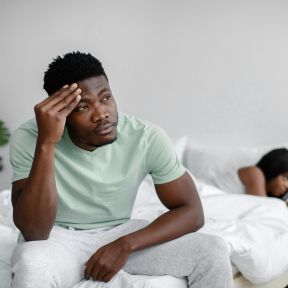Sexual Concerns
On This Page
Low sexual desire is one of the most common sexual concerns that women bring to therapy. More than a third of women report experiencing it at some point, but it affects as many as one in five men as well, though they may be less likely to discuss it. Aside from physical concerns, the most common reasons women may experience low desire is that their partner desires sex more than they do—not in itself a sign that their own level of desire is low; too little time spent getting “in the mood” for sex; a hesitance to tell partners what type of sex they like or want; and shame over feeling sexual desire.
As with other sexual concerns, therapists suggest that the first step in addressing low sexual desire is to discuss it openly with a partner. Believing that sexual attraction varies over time, and can be strengthened with effort, is often an important step in relieving stress over the issue. Having more sex tends not to resolve the issue and may only make it worse because of the increased stress of potentially seeing sex as a chore.
Counseling is recommended before any medical treatments to determine if the problem may be a lack of communication or some other issue within a relationship. Low sexual desire in men is sometime treated with testosterone supplements, but men should not take such supplements without first consulting a doctor. Years of research into a medication to treat low female desire has yet to yield a magic pill, or a female Viagra. But greater sexual education, and the practice of mindfulness around sex, often helps.
Couples in which partners initiate sex about an equal amount report being more satisfied in their relationships than other couples. One partner may come to resent always having to initiate sex, or the other may grow tired of always being chased when they may not desire sex. Communication about roles can go a long way toward resolving such concerns, as well as open talk about whether each partner’s personal desires are being met—often, they’ve never even been expressed.
In the absence of physical concerns, sexual desire discrepancy is often a matter of timing and energy. Discussing and understanding when each partner believes they will be most open to sex, and planning sex at those times, can go a long way toward resolving concerns over sexual frequency, as can treating sex as a distinct, special time by lighting candles or turning on music.
Early in a relationship, couples tend to be open to having sex often and without hesitation. Over time, that tends to change. After the “honeymoon phase” passes, partners may find that their sex drives no longer align as well, and they may have to deal with occasional sexual rejection for the first time since the relationship began. This is usually not a sign of a failing connection—unless it is ignored. Therapists recommend actions such as occasionally agreeing to sex even when desire is not initially strong and being conscious of reciprocating sexual interest when one is able.
It can be unsettling when your partner says no to sex. It can raise doubts about one’s desirability or the future of one’s relationship. The reality tends not be so serious: Often the issue has nothing to do with attraction, for example. Improved communication about sexual desire and increased understanding that sometimes two people simply don’t connect on a given day can go a long way toward resolving anxiety.
Sometimes when one partner desires sex, the other is in the middle of an important task, or worried about a family issue, or just too physically tired. Rejecting a partner, however, can out a strain on a couple’s connection. Clearly explaining why one is declining sex, rather than expressing annoyance, can help, as can suggesting a specific other time, ideally relatively soon. Finding another way to connect, such as sitting together or holding hands, can also go a long way toward maintaining closeness.
Women are more likely than men to report feeling pressured by a partner to have sex, or forced into it, to feeling resentment from partners when they decline sex, and to having sex even when they do not strongly desire it. Advocates for equality in relationships hope that greater awareness of continued imbalance in relationships will motivate men and women to talk about their differences in desire more openly.
The concept of sexual addiction is widely debated within the field of psychology. The World Health Organization recognizes “compulsive sexual behavior disorder” in its International Classification of Diseases (ICD-11), covering activities including casual sex with multiple partners, frequenting prostitutes, and using phone-sex or online sex-chat services. But many experts maintain that concepts like hypersexuality are just perceived problems with regulating one’s sexual thoughts or behaviors. Without agreement on the validity of the diagnosis, there’s no clear estimate of how many adults struggle with compulsive sexual behavior, but it’s believed to be between 3 and 6 percent.
No. A person’s belief that he or she is a addicted to sex is primarily based on their personal beliefs about their sexual habits or thoughts. Research finds that such people do not have more sex than individuals who report having no concern about their sex lives. Clinicians who diagnose compulsive sexual behavior disorder most often refer to patients’ pornography use, not their partnered sexual activity, although such individuals do not necessarily use porn more often than others, either.














